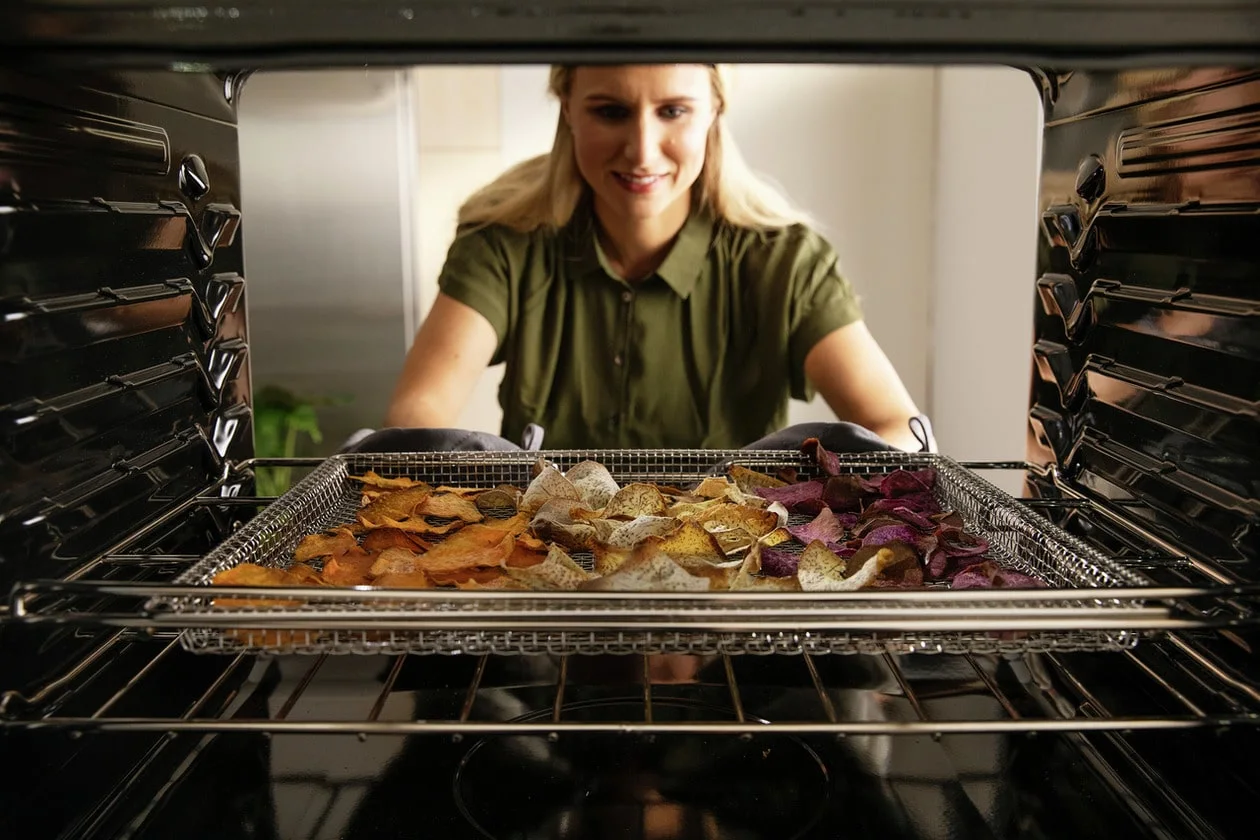
At a Glance:
To the joy of home cooks everywhere, premium kitchen brands have brought restaurant-caliber cooking technology to households, with recent innovations resulting in more evenly cooked meals being served to the table quicker than ever.
Convection and Air Fry ranges and wall ovens have upped the ante on how efficiently we can prepare our foods both in terms of how the cooking fuel is channeled and how fast we can serve up our favorite foods to our hungry patrons (a.k.a., our family members).
Browse Air Fry Ranges
If you want an air fry oven, explore options from leading manufacturers available at Colder's, today!
Shop Ranges with Air FryAir Fry… What is It?
Requiring far less oil than traditional oven-roasting and deep-frying methods, air frying your foods is a healthier cooking approach with minimal fat involved.
Available as an option in select ranges and wall ovens, the Air Fry setting replaces the need for a countertop air fryer or deep fryer. Air Fry ovens use convection fans to rapidly circulate extremely hot air around your fried favorites, resulting in evenly cooked foods with a crispy, golden exterior.
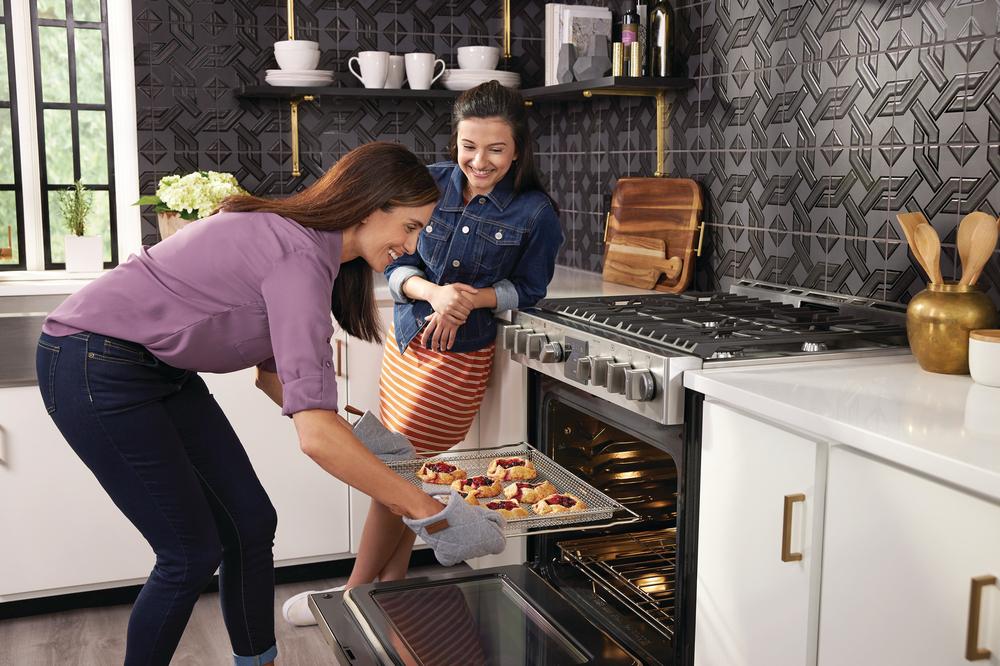
Powered at the touch of a button on all models available in the market currently (including the famed Air Fry ranges from Frigidaire Gallery), many ovens with Air Fry don’t require you to preheat your oven. To use this cooking mode, just place your tray of food on the rack, press the Air Fry button on your oven’s control panel, set the appropriate temperature between 350 and 500 degrees, and select “Start.”
So, What is Convection, Then?
Before there was Air Fry, there was convection. Shaking up the culinary possibilities ever since they were manufactured for residential kitchens, convection wall ovens and ranges rely on a fan to circulate fresh hot air over, under, and all around your food, evenly distributing heat throughout the oven cavity.
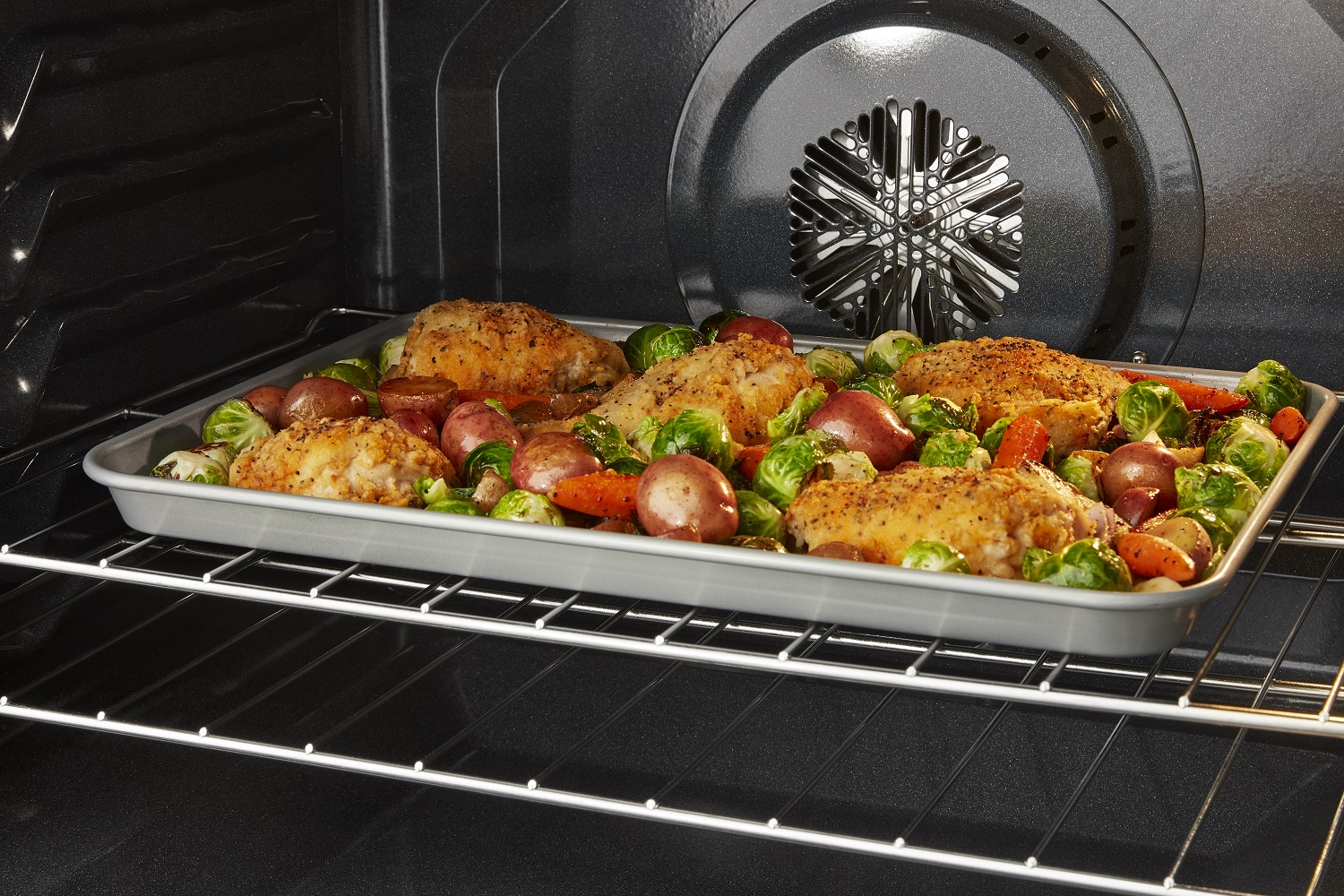
Convection ovens are highly efficient, resulting in more evenly cooked foods being ready about 25 percent faster than a traditional bake. Most compellingly, thanks to the convection setting, your meals can retain their flavor without losing any natural juices or smoking out the nutrients during the baking process.
That said, it should be noted that there are distinctions between convection settings. With standard convection ovens, there is still a posterior fan that circulates heat, but the hot air is coming from the elements at the bottom of the cavity, just like in a traditional oven. Due to the heat rising from the bottom, a drawback of convection is that it struggles to bake multiple racks at once, so there may not be even results across the top, middle, and bottom racks.
But then, there is true convection. Also termed as “European” or “True European” convection, this setting features an additional heating element behind the fan. With true convection, the oven’s heat is coming from the back of the cavity rather than from the bottom while circulating fresh hot air rather than pre-heated air. With true convection, you can bake on all your racks and achieve equal results no matter where you set down your tray or pan.
Okay, So What is the Difference?
Despite their similarly golden, crisp results, Air Fry differs from convection baking and vice versa. Their differences are mainly rooted in the speed at which the convection fans operate and the temperature of the oven. Compared to convection, Air Fry steps it up on both counts.
In terms of when you should use either setting, Air Fry is recommended for foods that cook with dry heat or that you would roast, bake, and fry. To list a few examples, pre-fried frozen foods, like chicken tenders, pizza rolls, and fish sticks, get appealingly crispy when baked with the Air Fry setting.
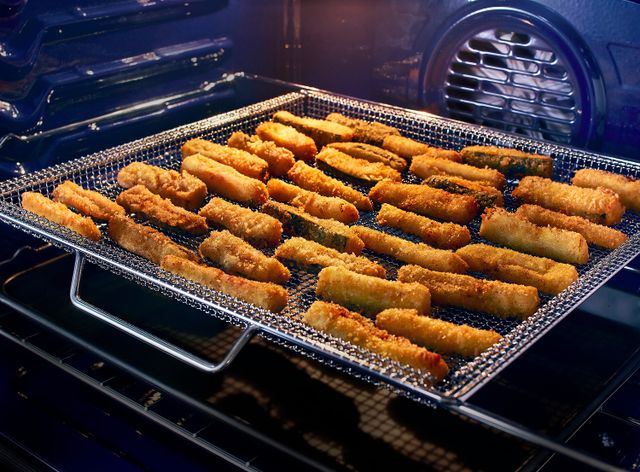
In addition, you can achieve great results from vegetables you’d roast or grill, potatoes, chicken wings, hot dogs (yes, hot dogs!), and from-scratch foods that mimic pre-fried frozen foods, like mozzarella sticks and crab cakes. That said, don’t be afraid to experiment.
Pro tip:
When using the Air Fry setting, use minimal oil to avoid soggy results. Lightly spray, using no more than 1 tablespoon of oil. Avocado, grapeseed, peanut, and extra-light olive oils achieve the crispiest results. Extra-virgin olive oil and other vegetable oils can cause food to dry up quickly and prevent them from getting crispy.
With a few exceptions, you can bake just about anything with the convection setting. Roasted meats thrive when heated in a convection oven, as the drier environment cooks them more thoroughly and brings out the spicy and herbal flavors of marinated skins.
If you’re covering up casseroles with a lid or a sheet of aluminum foil, the moisture loss associated with convection is not an issue, so you might as well use this setting to cook your entrées faster.
Most desserts get the green light, too, as convection heat creates steam faster to raise pie doughs and pastries—and don’t get us started on cookies. When you’re baking multiple batches, these ovens’ efficiency makes it easier to dole out dozens in record time. On the convection “no-no” list are custards, souffles, cakes, and breads, as these run the risk of baking unevenly, rising less impressively, and developing unpleasant crusts.
Currently, convection ovens are more broadly available compared to Air Fry ovens.
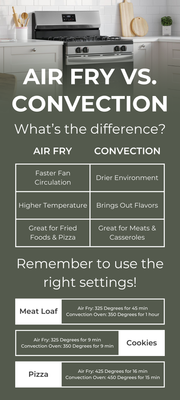
Learn more: What to Look for When Shopping for Ranges [2021 Range Buying Guide]
Air Fry vs. Convection Cheat Sheet
Because air frying and convection cooking both operate with increased heat being directed in a more encompassing manner, you may need to modify the temperature and cooking times for recipes of your favorite foods.
To bake a recipe using an Air Fry oven, reduce the temperature by 25 degrees and decrease the cook time by about 20 percent. To calculate the timing of the bake, multiply the cook time in minutes by 0.8. The resulting number is the estimated number of minutes it will take your Air Fry oven to churn out your fried food.
By contrast, there are two options you can try when using a convection setting. The first option is decreasing the cook time by about 25 percent (i.e., multiplying the listed time in minutes by 0.75) while retaining the oven temperature set forth by the recipe for a conventional oven.
The second option is to reduce the oven temperature by 25 degrees and abide by the cook time in the recipe. (If you ask us, the second convection option is generally preferred while the first option is an alternative for those who are cooking on a time crunch.)
For your convenience, we also provided a cheat sheet with approximate temperature and cook time conversions for popular entrées and desserts.
NOTE:
Some Air Fry and convection ovens automatically lower the temperature by 25 degrees when either setting is in use. As such, we advise reading your user manual closely before converting oven temperatures for recipes.
| Food | Traditional Oven | Air Fry Option | Convection Option #1 | Convection Option #2 |
|---|---|---|---|---|
| Meatloaf (1.5 pounds) | 350 degrees for 1 hour | 325 degrees for 45 minutes | 350 degrees for 45 minutes | 325 degrees for 1 hour |
| Roasted chicken (5 or 6 pounds) | 425 degrees for 1 hour 30 minutes | 400 degrees for 1 hour 12 minutes | 425 degrees for 1 hour 8 minutes | 400 degrees for 1 hour 30 minutes |
| Salmon (2 pounds) | 375 degrees for 15 minutes | 350 degrees for 12 minutes | 375 degrees for 11 minutes | 350 degrees for 15 minutes |
| Pizza (12-inch crust) | 450 degrees for 20 minutes | 425 degrees for 16 minutes | 450 degrees for 15 minutes | 425 degrees for 20 minutes |
| Roasted vegetables | 400 degrees for 55 minutes | 375 degrees for 45 minutes | 400 degrees for 40 minutes | 375 degrees for 55 minutes |
| Brownies | 350 degrees for 30 minutes | 325 degrees for 25 minutes | 350 degrees for 22 minutes | 325 minutes for 30 minutes |
| Cookies | 350 degrees for 12 minutes | 325 degrees for 9 minutes | 350 degrees for 9 minutes | 325 degrees for 12 minutes |
For our air-fried recipe, we turn to our friends at Frigidaire for instructions on how to bake buffalo chicken wings!
To create a delectably spicy wing sauce, Frigidaire’s experts recommend combining one cup of Frank's Wing Sauce , one stick of butter, and one tablespoon of ground cayenne pepper and heating these ingredients in a saucepan. After you cook your wings, just toss them in a large bowl with the hot wing sauce before you take your first bite.
RECIPE Buffalo Chicken Wings
- PREP TIME: 15 MINUTES
- COOK TIME: 35 MINUTES
- TOTAL TIME: 50 MINUTES
- COURSE: APPETIZER
Ingredients:
- Fresh chicken wings, 3 pounds
- 2 tablespoons of avocado oil
- 1 teaspoon of salt
- ½-teaspoon of ground cayenne pepper
Directions:
- Depending on your Air Fry model, preheat your oven at 450 degrees (some are marketed as “No Preheat”).
- Cut chicken wings at the joint and remove the flapper.
- Dry wings with a paper towel.
- Place dried wings on a baking tray lined with a paper towel and store the tray in the refrigerator for one hour.
- After one hour, remove the wings and place them in a gallon plastic bag.
- Add olive oil, salt, and ground cayenne pepper in a gallon plastic bag with the wings.
- Remove the wings and place them on a dark baking sheet or air frying tray drizzled with a non-stick spray.
- Select the “Air Fry” option on your oven to bake the wings at 450 degrees for 35 minutes.
Bonus: Convection Oven Recipe
Convection rapidly dissipates moisture, crisping your meals to golden satisfaction. An ideal candidate for this cooking method, this macaroni and cheese recipe has been modified for the convection setting so you can get a taste of gourmet ooey gooey-ness.
RECIPE Baked Mac and Cheese
- PREP TIME: 15 MINUTES
- COOK TIME: 45 MINUTES
- TOTAL TIME: 1 HOUR
- COURSE: APPETIZER
- SERVINGS: 4-6
Ingredients:
- Elbow macaroni, 1 pound
- 4 to 5 tablespoons (2 to 2½ ounces) of unsalted butter
- 3 tablespoons of all-purpose flour
- 2½ cups of whole milk
- 1 to 1¼ teaspoons of salt
- 1/8 teaspoon of black ground pepper
- 3 cups of shredded extra-sharp cheddar cheese
- ½-cup of grated Parmesan cheese
- ½-cup of dried breadcrumbs
- 1/8 to ¼ teaspoon of dry mustard (optional)
- A pinch to 1/8 teaspoon of freshly grated nutmeg (optional)
Directions:
- Preheat the convection oven to 375 degrees.
- Salt a large pot of water generously. Bring the water to a boil and then add the macaroni and cook according to the package directions.
- Meanwhile, melt the butter in a medium, heavy saucepan over medium heat. Sprinkle the flour over the butter and whisk until smooth, for 2 to 3 minutes.
- As you’re whisking, slowly pour in the milk. Lower the heat and simmer until creamy and smooth for 7 to 8 minutes.
- Add the salt and pepper (in addition to the dry mustard and/or nutmeg, if preferred). Take the pan off the heat and add 2½ cups of shredded cheddar and a ¼ -cup of Parmesan cheese. Whisk until the cheese is melted and the sauce is smooth.
- Drain the macaroni and return it to the pot. Dump the sauce on top of the macaroni and toss thoroughly to coat. Pour the macaroni mixture into a large cast-iron skillet. Sprinkle evenly with the remaining cheddar and Parmesan.
- Melt the remaining butter in a small skillet. Drizzle the melted butter over the breadcrumbs in a bowl and toss to coat. Sprinkle the breadcrumbs over the macaroni.
- Bake for 45 minutes or until the crumbs are browned. Cover the dish after 15 minutes to prevent the crumbs from browning too much.
- After baking, let the tray rest for about 10 minutes before enjoying!
Air Fryer Ranges
Cooking technology has come a long way, and ranges with air fryer technology are one of the latest innovations in kitchen appliances. This type of range combines traditional convection cooking with advanced air frying capabilities to provide faster, more even heating for food preparation. With electric or gas range options available, you can now enjoy restaurant-level meals at home without having to wait too long for them to be cooked.
Recommended Electric Range with Air Fryer
Frigidaire Gallery® 30" Stainless Steel Freestanding Induction Range with Air Fry
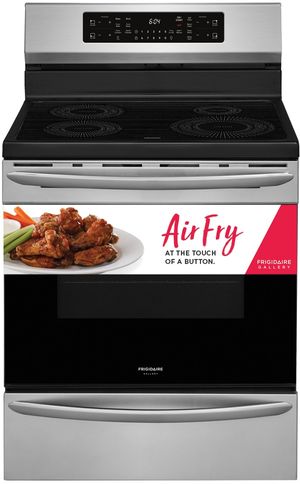
This Frigidaire Gallery range does it all. Its induction cooking surface boils water 50% faster than regular gas or electric stoves. True Convection technology means your baked goods come out perfect each and everytime. Best of all, you'll love the ease of its Air Fry functionality. Not to mention this was the very first range to market which offered such an innovation.
Recommended Gas Range with Air Fryer
LG 30" PrintProof™ Stainless Steel Freestanding Gas Range
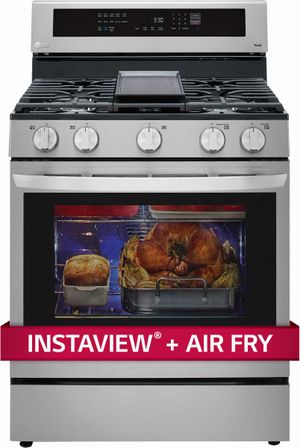
For those who prefer cooking with gas, we recommend this LG gas range with air fryer. In addition to its air fry oven, you can also take advantage of LG's fastest burner. With 20,000 BTU, this is one range where time is never wasted.
Air Fry FAQ
Is air fried food healthy?
Yes, air fried food is generally viewed as a healthier alternative to traditional deep-fried items since it uses less oil and requires less fat.
What cannot be cooked in air fryer?
There are certain items that should not be cooked in an air fryer such as foods with a wet batter. You should also never attempt to cook an entire roast or whole chicken. Rice, popcorn, raw vegetables, and most types of cheese should also be avoided.
Do you need special pans for air fryer oven?
No, you don't need special pans for air fryer ovens. Anything oven-safe can go in an air frying oven.
Why Trust Colder’s?
Since 1942, we at Colder's pride ourselves on offering value, selection, and service. Serving Southeastern Wisconsin with four showrooms that stock quality name-brand furniture, appliances, and mattresses, Colder’s is sure to house exactly what you are looking for. And if you can't find it on our floors, chances are, we can order it for you. As a local, family-owned company, we are always doing our best to provide the highest value at the lowest cost to everyone who walks through our doors.
Colder’s is committed not only to continuously offering can’t-miss sales but also to working with each customer, making sure that you take advantage of every possible markdown — that’s our best price guarantee.
Hungry for More?
There’s more than that came from! Check out our Appliances catalog to see how you can expand your culinary possibilities today. If you have any questions, don’t hesitate to call us at 1-414-476-1574 or visit our experts at any of our four Southeastern Wisconsin locations. More accessible than ever, we can also be reached via chat!
